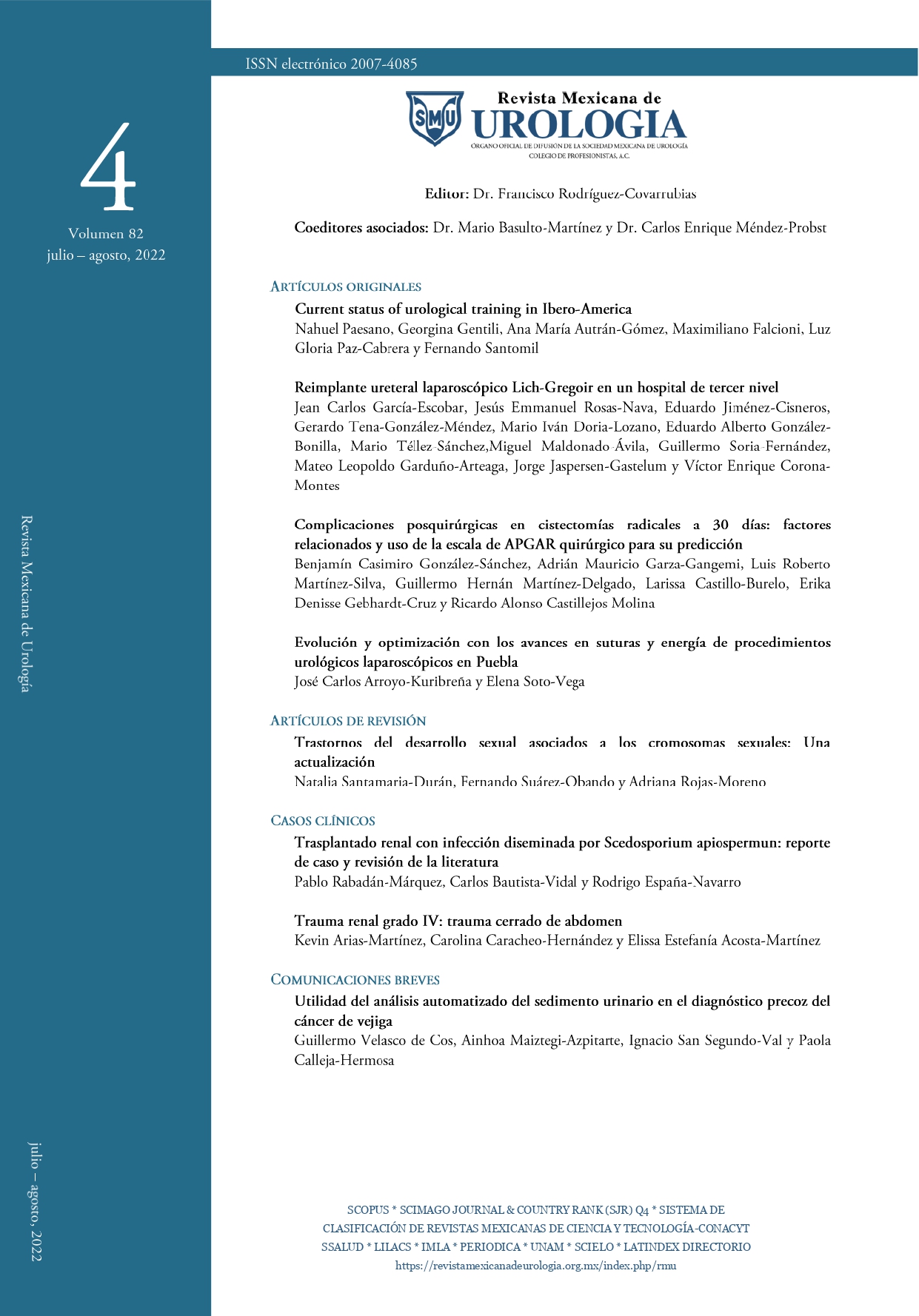Evolution and optimization of laparoscopic urological procedures with new sutures and energy in Puebla
DOI:
https://doi.org/10.48193/revistamexicanadeurologa.v82i4.894Keywords:
Prostatectomy, laparoscopy , nephrectomy , suturesAbstract
Objective: To analyze the evolution of laparoscopic surgery and the influence of technical elements, such as the use of bipolar grasper and barbed suture in surgical success.
Methodology: A retrospective review of medical files and surgical videos of laparoscopic procedures of a single surgeon was done. Descriptive statistics was performed in search of differences in surgical time and bleeding.
Results: A total of 140 procedures were included, with 89.3% performed in private hospitals, mostly radical prostatectomy (42.8%), radical nephrectomy (33.5%), partial nephrectomy (5.7%), and others. The average surgical time was 130.2 minutes, with an average bleeding of 430cc, with only 4 severe complications (2.1%), and a low mortality rate of 0.7%. The conversion rate to open surgery was 1.4%. The hospital stay was in average 2.4 days. The implementation of bipolar grasper and barbed sutures diminished the surgical time and bleeding.
Study limitations: Because this is a single surgeon’s experience in time, with diverse surgical procedures, a multicentric comparative study should be undertaken to confirm the results.
Originality: In Mexico, there are no studies that evaluate the use of technology in laparoscopic urologic surgery.
Conclusions: This paper reports on the evolution of the surgeon’s technique and experience, which have enabled an optimization in surgical times and postoperative outcomes associated to the use of the technology for dissection and the use of barbed sutures to improve results.
References
Clayman RV, Kavoussi LR, Soper NJ, Dierks SM, Merety KS, Darcy MD, et al. Laparoscopic nephrectomy. N Engl J Med. 1991;324(19):1370–1. doi: https://doi.org/10.1056/nejm199105093241917
Schuessler WW, Schulam PG, Clayman RV, Kavoussi LR. Laparoscopic radical prostatectomy: initial short-term experience. Urology. 1997;50(6):854–7. doi: https://doi.org/10.1016/s0090-4295(97)00543-8
Raboy A, Ferzli G, Albert P. Initial experience with extraperitoneal endoscopic radical retropubic prostatectomy. Urology. 1997;50(6):849–53. doi: https://doi.org/10.1016/s0090-4295(97)00485-8
Guillonneau B, Cathelineau X, Barret E, Rozet F, Vallancien G. Laparoscopic radical prostatectomy: technical and early oncological assessment of 40 operations. Eur Urol. 1999;36(1):14–20. doi: https://doi.org/10.1159/000019921
Binder J, Kramer W. Robotically-assisted laparoscopic radical prostatectomy. BJU Int. 2001;87(4):408–10. doi: https://doi.org/10.1046/j.1464-410x.2001.00115.x
Lin Y-F, Lai S-K, Liu Q-Y, Liao B-H, Huang J, Du L, et al. Efficacy and safety of barbed suture in minimally invasive radical prostatectomy: A systematic review and meta-analysis. Kaohsiung J Med Sci. 2017;33(3):107–15. doi: https://doi.org/10.1016/j.kjms.2016.12.005
Soto-Vega E, Torres-Perez JR, Arroyo C. Use of the radiofrequency Caiman® Aesculap® Grasper in three different laparoscopic urologic procedures with video. Trends Med. 2018;18(3).
Okhunov Z, Yoon R, Lusch A, Spradling K, Suarez M, Kaler KS, et al. Evaluation and Comparison of Contemporary Energy-Based Surgical Vessel Sealing Devices. J Endourol. 2018;32(4):329–37. doi: https://doi.org/10.1089/end.2017.0596
Arroyo C, Dib JE. Primer curso teórico-práctico “Dr. Jorge Elías Dib” de laparoscopia en urología. Rev Mex Urol. 2005;65(6):480–1.
Linden-Castro E, Pelayo-Nieto M, Ramírez-Galindo I, Guzmán-Hernández F, Catalán-Quinto G, Rodríguez-Covarrubias F, et al. Entrenamiento de urología en México: Perspectiva del residente. Gac Med Mex. 2016; 152:339–44.
Arroyo C. Prostatectomía radical laparoscópica extraperitoneal con plastia inguinal. Descripción de la técnica. Revista Mexicana de Urología. 2007;67(2):102–7.
Rodríguez-Covarrubias F, Martínez Liévano L, Gabilondo Pliego B, Gabilondo Navarro F, Atisha-Fregoso Y, Arroyo C. Simulador computarizado de inmersión virtual como modelo de inicio de entrenamiento de laparoscopia urológica. Actas Urológicas Españolas. 2006;30(8):819–23.
Akita H, Okamura T, Naiki T, Nagata D, Tozawa K, Kohri K. Evaluation of the Outcome of Laparoscopic Radical Prostatectomy by a Single Surgeon: Experience with an Initial 30 Cases. Journal of Rural Medicine. 2010;5(1):134–9. doi: https://doi.org/10.2185/jrm.5.134
Gregori A, Simonato A, Lissiani A, Bozzola A, Galli S, Gaboardi F. Laparoscopic radical prostatectomy: perioperative complications in an initial and consecutive series of 80 cases. Eur Urol. 2003;44(2):190–4; discussion 194. doi: https://doi.org/10.1016/s0302-2838(03)00261-6
Guillonneau B, Rozet F, Cathelineau X, Lay F, Barret E, Doublet J-D, et al. Perioperative complications of laparoscopic radical prostatectomy: the Montsouris 3-year experience. J Urol. 2002 Jan;167(1):51–6.
Eden CG, Cahill D, Vass JA, Adams TH, Dauleh MI. Laparoscopic radical prostatectomy: the initial UK series. BJU Int. 2002;90(9):876–82. doi: https://doi.org/10.1046/j.1464-410x.2002.03049.x
Rassweiler J, Sentker L, Seemann O, Hatzinger M, Rumpelt HJ. Laparoscopic radical prostatectomy with the Heilbronn technique: an analysis of the first 180 cases. J Urol. 2001;166(6):2101–8.
Akdere H, Aktoz T, Arıkan MG, Atakan İH, Veneziano D, Gözen AS. Embarking with laparoscopic radical prostatectomy and dealing with the complications and collateral problems: A single-center experience. Turkish Journal of Urology. 2020;46(1):37.
Dirie NI, Wang Q, Wang S. Two-Dimensional Versus Three-Dimensional Laparoscopic Systems in Urology: A Systematic Review and Meta-Analysis. J Endourol. 2018;32(9):781–90. doi: 10.1089/end.2018.0411
Bertolo R, Checcucci E, Amparore D, Autorino R, Breda A, Ramirez-Backhaus M, et al. Current Status of Three-Dimensional Laparoscopy in Urology: An ESUT Systematic Review and Cumulative Analysis. J Endourol. 2018;32(11):1021–7. doi: https://doi.org/10.1089/end.2018.0374






